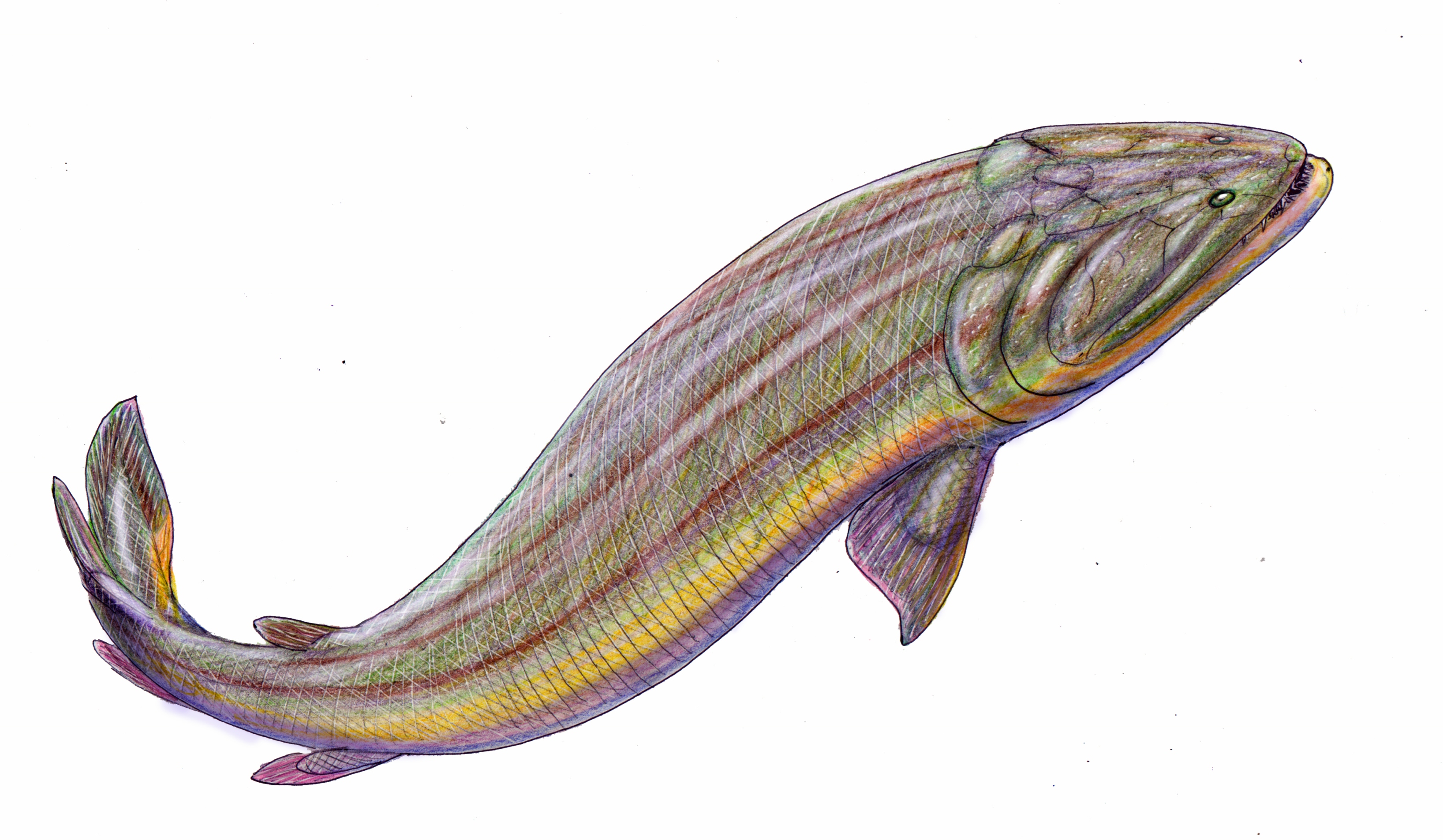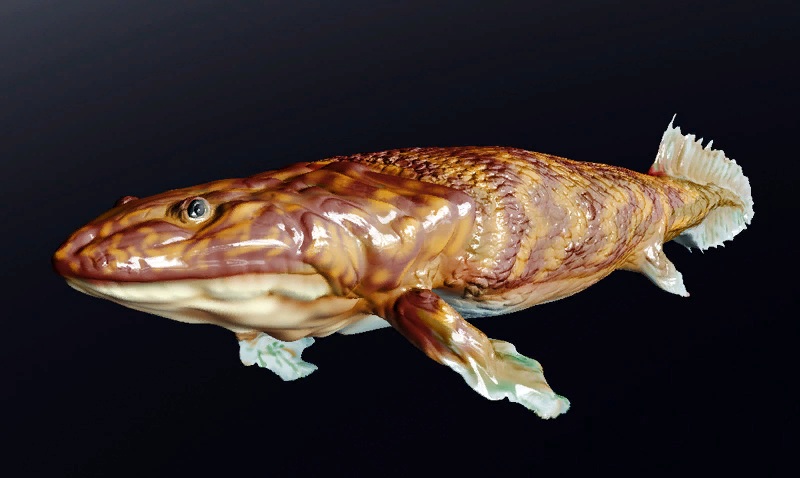|
Sarcopterygii
Sarcopterygii (; ) — sometimes considered synonymous with Crossopterygii () — is a taxon (traditionally a class or subclass) of the bony fishes known as the lobe-finned fishes. The group Tetrapoda, a mostly terrestrial superclass including amphibians, sauropsids (reptiles, including dinosaurs and therefore birds) and synapsids (with mammals being the only extant group), evolved from certain sarcopterygians; under a cladistic view, tetrapods are themselves considered a subgroup within Sarcopterygii. The known extant non-tetrapod sarcopterygians include two species of coelacanths and six species of lungfishes. Characteristics Early lobe-finned fishes are bony fish with fleshy, lobed, paired fins, which are joined to the body by a single bone. The fins of lobe-finned fishes differ from those of all other fish in that each is borne on a fleshy, lobelike, scaly stalk extending from the body. The scales of sarcopterygians are true scaloids, consisting of lamellar bone surro ... [...More Info...] [...Related Items...] OR: [Wikipedia] [Google] [Baidu] |
Osteichthyes
Osteichthyes (), popularly referred to as the bony fish, is a diverse superclass of fish that have skeletons primarily composed of bone tissue. They can be contrasted with the Chondrichthyes, which have skeletons primarily composed of cartilage. The vast majority of fish are members of Osteichthyes, which is an extremely diverse and abundant group consisting of 45 orders, and over 435 families and 28,000 species. It is the largest class of vertebrates in existence today. The group Osteichthyes is divided into the ray-finned fish ( Actinopterygii) and lobe-finned fish ( Sarcopterygii). The oldest known fossils of bony fish are about 425 million years old, which are also transitional fossils, showing a tooth pattern that is in between the tooth rows of sharks and bony fishes. Osteichthyes can be compared to Euteleostomi. In paleontology the terms are synonymous. In ichthyology the difference is that Euteleostomi presents a cladistic view which includes the terrestria ... [...More Info...] [...Related Items...] OR: [Wikipedia] [Google] [Baidu] |
Lungfish
Lungfish are freshwater vertebrates belonging to the order Dipnoi. Lungfish are best known for retaining ancestral characteristics within the Osteichthyes, including the ability to breathe air, and ancestral structures within Sarcopterygii, including the presence of lobed fins with a well-developed internal skeleton. Lungfish represent the closest living relatives of the tetrapods. Today there are only six known species of lungfish, living in Africa, South America, and Australia. The fossil record shows that lungfish were abundant since the Triassic. While vicariance would suggest this represents an ancient distribution limited to the Mesozoic supercontinent Gondwana, the fossil record suggests advanced lungfish had a widespread freshwater distribution and the current distribution of modern lungfish species reflects extinction of many lineages subsequent to the breakup of Pangaea, Gondwana and Laurasia. Lungfish have historically been referred to as salamanderfish, but ... [...More Info...] [...Related Items...] OR: [Wikipedia] [Google] [Baidu] |
Dipnomorpha
Lungfish are freshwater vertebrates belonging to the order Dipnoi. Lungfish are best known for retaining ancestral characteristics within the Osteichthyes, including the ability to breathe air, and ancestral structures within Sarcopterygii, including the presence of lobed fins with a well-developed internal skeleton. Lungfish represent the closest living relatives of the tetrapods. Today there are only six known species of lungfish, living in Africa, South America, and Australia. The fossil record shows that lungfish were abundant since the Triassic. While vicariance would suggest this represents an ancient distribution limited to the Mesozoic supercontinent Gondwana, the fossil record suggests advanced lungfish had a widespread freshwater distribution and the current distribution of modern lungfish species reflects extinction of many lineages subsequent to the breakup of Pangaea, Gondwana and Laurasia. Lungfish have historically been referred to as salamanderfish, but this t ... [...More Info...] [...Related Items...] OR: [Wikipedia] [Google] [Baidu] |
Coelacanth
The coelacanths ( ) are fish belonging to the order Actinistia that includes two extant species in the genus ''Latimeria'': the West Indian Ocean coelacanth (''Latimeria chalumnae''), primarily found near the Comoro Islands off the east coast of Africa, and the Indonesian coelacanth (''Latimeria menadoensis''). The name "coelacanth" originates from the Permian genus '' Coelacanthus'', which was the first scientifically named coelacanth. Coelacanths follow the oldest-known living lineage of Sarcopterygii (lobe-finned fish and tetrapods), which means they are more closely related to lungfish and tetrapods (which includes amphibians, reptiles, birds and mammals) than to ray-finned fish. They are found along the coastline of Indonesia and in the Indian Ocean. The West Indian Ocean coelacanth is a critically endangered species. The oldest known coelacanth fossils are over 410 million years old. Coelacanths were thought to have become extinct in the Late Cretaceous, around 66 m ... [...More Info...] [...Related Items...] OR: [Wikipedia] [Google] [Baidu] |
Actinistia
The coelacanths ( ) are fish belonging to the order Actinistia that includes two extant species in the genus ''Latimeria'': the West Indian Ocean coelacanth (''Latimeria chalumnae''), primarily found near the Comoro Islands off the east coast of Africa, and the Indonesian coelacanth (''Latimeria menadoensis''). The name "coelacanth" originates from the Permian genus '' Coelacanthus'', which was the first scientifically named coelacanth. Coelacanths follow the oldest-known living lineage of Sarcopterygii (lobe-finned fish and tetrapods), which means they are more closely related to lungfish and tetrapods (which includes amphibians, reptiles, birds and mammals) than to ray-finned fish. They are found along the coastline of Indonesia and in the Indian Ocean. The West Indian Ocean coelacanth is a critically endangered species. The oldest known coelacanth fossils are over 410 million years old. Coelacanths were thought to have become extinct in the Late Cretaceous, around 66 mi ... [...More Info...] [...Related Items...] OR: [Wikipedia] [Google] [Baidu] |
Tetrapodomorpha
The Tetrapodomorpha (also known as Choanata) are a clade of vertebrates consisting of tetrapods (four-limbed vertebrates) and their closest sarcopterygian relatives that are more closely related to living tetrapods than to living lungfish. Advanced forms transitional between fish and the early labyrinthodonts, such as '' Tiktaalik'', have been referred to as "fishapods" by their discoverers, being half-fish, half-tetrapods, in appearance and limb morphology. The Tetrapodomorpha contains the crown group tetrapods (the last common ancestor of living tetrapods and all of its descendants) and several groups of early stem tetrapods, which includes several groups of related lobe-finned fishes, collectively known as the osteolepiforms. The Tetrapodamorpha minus the crown group Tetrapoda are the Stem Tetrapoda, a paraphyletic unit encompassing the fish to tetrapod transition. Among the characteristics defining tetrapodomorphs are modifications to the fins, notably a humerus with convex ... [...More Info...] [...Related Items...] OR: [Wikipedia] [Google] [Baidu] |
Onychodontiformes
Onychodontiformes (also known as Onychodontida and Struniiformes) is an order of prehistoric sarcopterygian fish that lived during the Devonian period. The onychodontiforms are generally regarded as early-diverging members of the coelacanth lineage. Phylogeny The following cladogram is adapted from Mondéjar-Fernández (2020). The study recovered Onychodontiformes as a paraphyletic In taxonomy, a group is paraphyletic if it consists of the group's last common ancestor and most of its descendants, excluding a few monophyletic subgroups. The group is said to be paraphyletic ''with respect to'' the excluded subgroups. In ... group, which is shown in green: References External links Onychodontiformes at Palaeos Prehistoric lobe-finned fish Prehistoric fish orders Devonian bony fish Early Devonian first appearances Famennian extinctions Paraphyletic groups {{paleo-lobefinned-fish-stub ... [...More Info...] [...Related Items...] OR: [Wikipedia] [Google] [Baidu] |
Rhipidistia
Rhipidistia, also known as Dipnotetrapodomorpha, is a clade of lobe-finned fishes which includes the tetrapods and lungfishes. Rhipidistia formerly referred to a subgroup of Sarcopterygii consisting of the Porolepiformes and Osteolepiformes, a definition that is now obsolete. However, as cladistic understanding of the vertebrates has improved over the last few decades, a monophyletic Rhipidistia is now understood to include the whole of Tetrapoda and the lungfishes. Rhipidistia includes Porolepiformes and Dipnoi. Extensive fossilization of lungfishes has contributed to many evolutionary studies of this group. Evolution of autostylic jaw suspension, in which the palatoquadrate bone fuses to the cranium, and the lymph pumping "lymph heart" (later lost in mammals and flying birds), are unique to this group. The precise time at which the choana The choanae (singular choana), posterior nasal apertures or internal nostrils are two openings found at the back of the nasal passage b ... [...More Info...] [...Related Items...] OR: [Wikipedia] [Google] [Baidu] |
Tetrapodomorph
The Tetrapodomorpha (also known as Choanata) are a clade of vertebrates consisting of tetrapods (four-limbed vertebrates) and their closest sarcopterygian relatives that are more closely related to living tetrapods than to living lungfish. Advanced forms transitional between fish and the early labyrinthodonts, such as ''Tiktaalik'', have been referred to as "fishapods" by their discoverers, being half-fish, half-tetrapods, in appearance and limb morphology. The Tetrapodomorpha contains the crown group tetrapods (the last common ancestor of living tetrapods and all of its descendants) and several groups of early stem tetrapods, which includes several groups of related lobe-finned fishes, collectively known as the osteolepiforms. The Tetrapodamorpha minus the crown group Tetrapoda are the Stem Tetrapoda, a paraphyletic unit encompassing the fish to tetrapod transition. Among the characteristics defining tetrapodomorphs are modifications to the fins, notably a humerus with convex h ... [...More Info...] [...Related Items...] OR: [Wikipedia] [Google] [Baidu] |
Panderichthys
''Panderichthys'' is a genus of extinct sarcopterygian (lobe-finned fish) from the late Devonian period, about 380 Mya. ''Panderichthys'', which was recovered from Frasnian (early Late Devonian) deposits in Latvia, is represented by two species. ''P. stolbovi'' is known only from some snout fragments and an incomplete lower jaw. ''P. rhombolepis'' is known from several more complete specimens. Although it probably belongs to a sister group of the earliest tetrapods, ''Panderichthys'' exhibits a range of features transitional between tristichopterid lobe-fin fishes (e.g., ''Eusthenopteron'') and early tetrapods. It is named after the German-Baltic paleontologist Christian Heinrich Pander. Possible tetrapod tracks dating back to before the appearance of ''Panderichthys'' in the fossil record were reported in 2010, which suggests that ''Panderichthys'' is not a direct ancestor of tetrapods, but nonetheless shows the traits that evolved during the fish-tetrapod evolution Discovery ... [...More Info...] [...Related Items...] OR: [Wikipedia] [Google] [Baidu] |
Australian Lungfish
The Australian lungfish (''Neoceratodus forsteri''), also known as the Queensland lungfish, Burnett salmon and barramunda, is the only surviving member of the family Neoceratodontidae. It is one of only six extant lungfish species in the world. Endemic to Australia, the Neoceratodontidae are an ancient family belonging to the class Sarcopterygii, or lobe-finned fishes. Fossil records of this group date back 380 million years, around the time when the higher vertebrate classes were beginning to evolve. Fossils of lungfish almost identical to this species have been uncovered in northern New South Wales, indicating that ''Neoceratodus'' has remained virtually unchanged for well over 100 million years, making it a living fossil and one of the oldest living vertebrate genera on the planet. It is one of six extant representatives of the ancient air-breathing Dipnoi (lungfishes) that flourished during the Devonian period (about 413–365 million years ago) and is the outgroup to a ... [...More Info...] [...Related Items...] OR: [Wikipedia] [Google] [Baidu] |
Guiyu Oneiros
''Guiyu oneiros'' is the earliest articulated bony fish discovered. The generic name ''Guiyu'' is a transliteration of the Mandarin 鬼魚 ''guǐyú'' "ghost fish" and the specific name ''oneiros'' is from Greek ὄνειρος "dream". Fossils of ''Guiyu'' have been found in what is now Qujing, Yunnan, China, in a late Silurian marine strata, about 425 million years old. ''Guiyu'' remains have been found articulated, missing only the caudal fin. The living fish is estimated to have been around 30 cm long. ''Guiyu'' was described by Chinese palaeontologist Zhu Min ( 朱敏) and others in 2009, based on a near-complete articulated specimen. It was described as a basal lobe-finned fish with anatomical features of both ray-finned and lobe-finned fishes, although, analysis of the totality of its features place it closer to the class Sarcopterygii (lobe-finned fishes). ''Guiyu'' sheds light on the early diversification of bony fishes. This clade, the osteichthyans, splits in tw ... [...More Info...] [...Related Items...] OR: [Wikipedia] [Google] [Baidu] |






